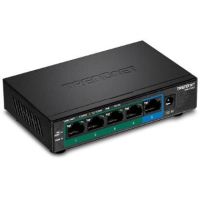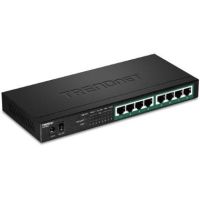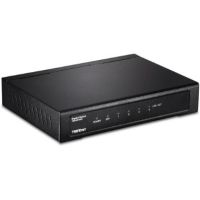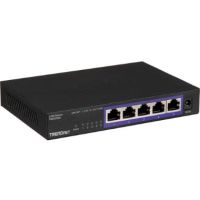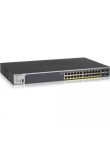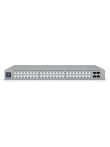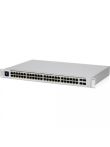Unmanaged Switches
- TRENDnet TPE-TG52 5-Port Gigabit PoE+ Compliant Unmanaged Ne...
 In Stock
In StockBrand: TRENDnet SKU: TPE-TG52 Condition: New USD 42.92 - TRENDnet TPE-TG84 8-Port Gigabit PoE+ Compliant Unmanaged Ne...
 In Stock
In StockBrand: TRENDnet SKU: TPE-TG84 Condition: New USD 93.28 - TRENDnet TEG-S51 5-Port Gigabit Unmanaged Network Switch
 In Stock
In StockBrand: TRENDnet SKU: TEG-S51 Condition: New USD 16.04 - TRENDnet TEG-S350 5-Port 2.5G Unmanaged Network Switch
 In Stock
In StockBrand: TRENDnet SKU: TEG-S350 Condition: New USD 69.74
Why Purchase an Unmanaged Switch in 2025?
For any network infrastructure, whether small, medium, large, or enterprise-grade, the role of network switches is critical. They connect multiple devices, such as access points, routers, VoIP phones, printers, and computers, to name a few, within a Local Area Network (LAN). However, network administrators need to choose from a variety of Ethernet switches, including managed switches, smart switches, and unmanaged switches.
Unmanaged switches are normally recommended for small networks for homes and small offices that don’t need any configuration or customization capabilities. They are essentially plug-and-play devices, requiring no specialized skills for their deployment and management. Though the world of networking has made rapid progress, not every kind of network needs the steep upfront costs of managed and smart managed switches.
In this write-up, we are going to discuss primary characteristics, benefits, and user scenarios of managed Ethernet switches. We will help you make a well-informed decision regarding why you should purchase unmanaged network switches for your network in the USA.
Understanding Unmanaged Switches:
Unmanaged switches are the simplest network switches, designed for basic network infrastructure. They use autonegotiated ports for determining connection benchmarks such as data rate and duplex settings.
Since they are plug-and-play devices, they don’t need any manual interventions, and they don’t support VLANs either. One highlighted feature of unmanaged switches is that they maintain a media access control (MAC) address table. MAC Table is capable of learning the MAC address of each device which are connected to the switch. In this way, they can track and map the addresses to the corresponding ports. The support for MAC table enables unmanaged Ethernet switches to maintain a separate collision domain for each port, reducing collisions and interventions.
Managed Switches vs Unmanaged Switches:
Managed switches are advanced network switches that allow network administrators to adjust each port on the switch, enabling them to monitor, manage, and configure networks in any way they deem fit.
Here is a table showing the differences between these Ethernet network switches available in the USA and beyond.
|
Features |
Managed Network Switches |
Unmanaged Network Switches |
|
Technical skills |
Demand professional IT experts for deployment/configuration |
Plug-and-Play devices |
|
Configuration |
Support advanced configuration customization |
No configuration |
|
SNMP support |
Yes |
No |
|
VLAN support |
Yes |
No |
|
Capabilities |
Spanning Tree Protocol, Quality of Service (QoS), bandwidth rate limiting, and port mirroring |
MAC address |
|
Security |
Advanced security features, including ACLs, Port Security, private VLAN, and 802.1x authentication |
No extra security features beyond basic needs |
|
Scalability |
Support for scalable network infrastructure |
Minimal scalability |
Why Choose an Unmanaged Switch for Your Network in the USA:
Despite the fact that managed switches offer an advanced level of customization and configuration capabilities, they are not recommended for every kind of infrastructure.
Here are some reasons that explain why you should go for these plug-and-play and simple network switches.
-
Low Cost:
The price of dumb switches is much lower than that of managed switches. They can cost almost 50 to 70 % less than what a managed switch can incur, making them suitable for budget-conscious network users. Furthermore, factors and industries where there is no need for advanced configuration options, users also prefer these no-configuration switches.
-
Easy Installation/Maintenance:
Unmanaged network switches don’t require any pre-configuration for installation and deployment, making them easy to install and run. You can connect multiple devices without any need for complex configuration. Network administrators can thus enjoy up to 30 to 40% quicker installation as compared to managed Ethernet switches.
-
Reliable for Basic Networks:
Unmanaged switches are suitable for small homes and small offices where advanced traffic control, monitoring, and scaling possibilities are not required. They are deployed for non-critical factory or industrial operations.
Factors to Look for in Unmanaged Network Switches in 2025:
Here are some factors that you should look into before making an ultimate decision.
-
Multi-Gigabit Speed:
Switches are rapidly undergoing improvement when it comes to the support that they can provide. You can now find switches supporting 2.5G, 5G, and 10G Ethernet ports, allowing users to handle bandwidth-intensive applications such as video conferencing, esports broadcasting, and more.
Similarly, uplink speed is also improving. There are multiple switches featuring uplink ports that can deliver 10G or higher speeds.
-
Port Count & Speed:
Port count is one of the most important features that you should look into. You can find multiple types of switches concerning this, for instance, 5-port switches, 8-port switches, 16-port switches, 24-port switches, and 48-port switches. As a thumb rule, small offices require 5- and 8-port switches, whereas large offices may need 24- or 48-port configurations for handling large file transfers, video conferencing, or cloud applications to prevent bottlenecks.
-
Power over Ethernet (PoE) Capability:
PoE is another important feature that you should look into. PoE can help you transmit both data and power to IT devices like IP cameras, phones, or wireless access points. You can thus save cost as well as cable clutter. In this regard, you need to check the total PoE budget or whether switches are PoE, PoE+, or PoE++.
|
Features |
PoE (IEEE 802.3af) or Type 1 |
PoE+ (IEEE 802.3at) or Type 2 |
PoE++ (IEEE 802.3bt) or Type 3/4 |
|
Max Power per Port |
15.4 W (12.95 W to device) |
30 W (25.5 W to device) |
Type 3: 60 W (51 W to device) |
|
Voltage Range |
44–57 V |
50–57 V |
50–57 V |
|
Power Delivery Method |
2 pairs of wires |
2 pairs of wires |
4 pairs of wires |
|
Cable Type |
Cat5 or better |
Cat5 or better |
Cat5e or better is recommended |
|
Typical Use Cases |
Basic IP phones, cameras, APs |
Advanced IP phones, PTZ cameras, and higher power APs |
High-power devices like multi-radio APs, building automation, TVs, and small PCs |
Where to Go for Unmanaged Network Switches in the USA:
Here are specific use cases where unmanaged switches should be preferred.
-
Home & Small Business Uses:
Unmanaged switches come with a compact design and support multiple mounting options, including desktop or wall-mount, and rackmount. You can thus use these switches with both cost and space saved. Furthermore, they are plug-and-play devices, adding more to their suitability for smaller network infrastructures.
Unmanaged switches come in various speeds. For instance, you can find 100 Mbps unmanaged switches or you can find even 1G unmanaged switches, allowing you to meet your basic network needs, such as an unmanaged switch for gaming, streaming, TV, and the like.
-
Industrial Uses:
These easy-to-manage switches have also become a preferred choice for industrial applications. They can be deployed in manufacturing, machining, oil & gas, and mining, etc, where no advanced level of configurability and customization is required.
Top Brands Offering Unmanaged Switches in the USA:
-
Netgear Unmanaged Switches
-
TP-Link Unmanaged Switches
-
TRENDnet Unmanaged Switches
-
QNAP Unmanaged Switches
-
Netgear Unmanaged Switches USA:
Netgear offers an extensive range of unmanaged switches, featuring Gigabit Ethernet speeds, PoE (Power over Ethernet) capabilities in some models, and multi-gigabit options for higher performance needs.
Port Speed:
In terms of primary port speed, users can find Gigabit Unmanaged switches as well as 10G and multi-gigabit unmanaged network switches. For instance,
Unmanaged PoE+ Switch (GS748PP) 48-Port Gigabit Ethernet Unmanaged PoE+ Switch (380W) is a high-end gigabit unmanaged switch, whereas 10-Gigabit/Multi-Gigabit (XS508M) 8-port, 5-speed Unmanaged Switch 10-Gigabit/Multi-Gigabit is a 10G unmanaged switch, suitable for ultra-fast network speed.
Number of Ports:
Netgear Unmanaged Switches USA also differ widely when it comes to the number of ports. You can find 5-port unmanaged switches as well as 48-port unmanaged switches, meeting your needs effectively.
For instance, the Gigabit Unmanaged Switch Series (GS748) 48-Port Gigabit Ethernet Unmanaged Switch is a high-end unmanaged switch suitable for medium and large networks. Similarly, the Unmanaged PoE Switch (GS105PPv3) 5-Port Gigabit Ethernet Unmanaged PoE+ Switch is a 5-port Netgear switch suggested for small SOHO (Small Office Small House) Networks.
Versatile Usability:
Netgear PoE unmanaged switches are wide-ranging. For instance, Netgear PoE unmanaged switches (supporting up to 15W per port), PoE+ unmanaged switches (supporting up to 30W per port), and Ultra PoE++ unmanaged switches (supporting up to 60W per port) are available. Similarly, Netgear also offers unmanaged switches with as low as 83W PoE budget to as high as 380W PoE budget.
For instance, the Unmanaged PoE Switch (GS105PPv3) 5-Port Gigabit Ethernet Unmanaged PoE+ Switch can deliver 380W PoE budget, whereas, 300 Series SOHO Unmanaged Switch (GS305PP) 5-Port Gigabit Ethernet SOHO Unmanaged Switch with 4-Ports PoE+ can provide 83W total PoE budget.
In addition to these capabilities, Netgear unmanaged switches are equipped with PoE autobalance and desktop, wall-mount, and rackmount form factors, allowing users to meet their varying needs effectively.
-
Trendnet Unmanaged Switches USA:
Trendnet unmanaged switches come in varying specifications, allowing users to meet their simple switching needs with ease and confidence.
-
You can find as simple as a 5-Port unmanaged switch, such as TEG-S350 5-Port Unmanaged 2.5G Switch, or you can choose as high as a 28-port unmanaged switch, such as 28-Port 2.5G Switch with 10G SFP+ Ports switch.
-
Speed is also wide-ranging. From fast Ethernet switches such as TEG-S50g 5-Port Gigabit GREENnet Mini Switch to 10G Trendnet Ethernet switches such as TEG-S7102 10-Port 10G Unmanaged Switch. You can find multiple options to suit your needs.
-
Similarly, you can also find unmanaged SFP, unmanaged SFP+ switches, as well as those switches that are fanless.
-
TP-Link Unmanaged Switches USA:
TP-Link is another popular unmanaged switch manufacturer in the USA, offering plug-and-play switches for various needs such as gaming, streaming, TV, and more. You can thus use TP-Link unmanaged network switches for building cheap network hubs.
TP-Link unmanaged Ethernet switches are wide-ranging, including 2.5 Gbps unmanaged switches, Gigabit PoE unmanaged switches, fast Ethernet PoE unmanaged switches, and fast Ethernet non-PoE unmanaged switches.
-
In terms of number of ports, you can purchase 5-port TP-Link unmanaged switches for basic networking needs, as well as 48-port TP-Link unmanaged switches. For instance, TL-SG1048 48-Port Gigabit Rackmount Switch is an enterprise-grade switch, whereas TL-SG1005P-PD 5-Port Gigabit Desktop PoE+ Switch with 1-Port PoE++ In and 4-Port PoE+Out is a simple and basic unmanaged switch.
-
TP-Link unmanaged switches also support multiple PoE protocols and a PoE budget. For instance, you can find 802.3af/at PoE+ (30W) unmanaged switches and 802.3af/at/bt PoE++ (60W) unmanaged switches. Similarly, TP-Link offers as high as 250W PoE budget, allowing users to power their IT devices with ease and convenience. For instance, TL-SG1218MP18-Port Gigabit Rackmount Switch with 16 PoE+ can deliver up to 250W PoE budget whereas, TL-SG1210P
10-Port Gigabit Desktop Switch with 8-Port PoE+ is capable of providing 63W output for PoE-compatible devices.
-
TP-Link unmanaged switches also support multiple PoE protocols and a PoE budget. For instance, you can find TP-Link’s 802.3af/at PoE+ (30W) unmanaged switches and 802.3af/at/bt PoE++ (60W) unmanaged switches. Similarly, TP-Link offers as high as 250W PoE budget, allowing users to power their IT devices with ease and convenience. For instance, TL-SG1218MP18-Port Gigabit Rackmount Switch with 16 PoE+ can deliver up to 250W PoE budget, whereas TL-SG1210P 10-Port Gigabit Desktop Switch with 8-Port PoE+ is capable of providing 63W output for PoE-compatible devices.
-
In addition to these, you can purchase specialized TP-Link unmanaged switches suitable for Wi-Fi 6 AP, surveillance, and static routing, and unmanaged switches with a fanless design.
-
QNAP Unmanaged Switches USA:
Similar to TP-Link, Netgear, and TRENDnet, QNAP has also carved out a unique name in the market when it comes to managed switches. The QNAP unmanaged switches offer several features and capabilities.
QNAP unmanaged switches come with several ports and 10GbE SFP+, 2.5 GbE RJ45, and 1 GbE RJ45 uplink speeds. Furthermore, you can find half-width rackmount and desktop-mount unmanaged switches.
Here are some examples.
-
QSW-2104-2T-R2 4-port 2.5GbE, and 2-port 10GbE multi-gig unmanaged switch can provide cost-effective upgradation of your network with four ports supporting.
-
QSW-3216R-8S8T Half-width Rackmount 16-Port 10GbE Unmanaged Switch is for an SMB/SOHO high-speed networking environment that can provide 10GbE SFP+ link speed for high-speed fiber optics networks.
-
QSW-1108-8T-R2 8-Port Full 2.5GbE Multi-Gig Switch is the right answer for your needs, like Smooth File Backups, Media Streaming, and Gaming.
Wrapping Up:
Simplified setup, cost-effectiveness, energy efficiency, and plug-and-play configuration make unmanaged switches suitable for small homes, small offices (SOHO), and industrial settings where no management capabilities are required. However, you need to choose these simple network switches carefully, giving due consideration to the number of ports, speed, PoE capabilities, and the like.
In the USA market, Netgear, QNAP, TP-Link, and Trendnet unmanaged switches are quite popular due to cost-effectiveness and feature-packed product ranges. We have shared some of their salient features so that you can make a well-informed decision when it comes to how to choose the best unmanaged switch for gaming, TV, streaming, security cameras, IP phones, routers, and access points in the USA.
Thanks for your reading.



